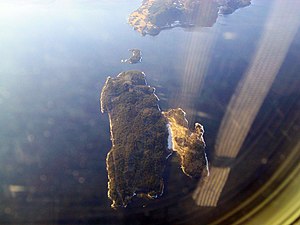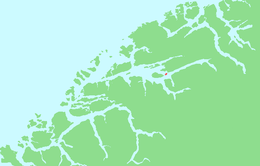Veøya

View of the island
|
|

Location in Møre og Romsdal
|
|
| Geography | |
|---|---|
| Location | Møre og Romsdal, Norway |
| Coordinates | 62°40′14″N 7°25′29″E / 62.6706°N 7.4248°ECoordinates: 62°40′14″N 7°25′29″E / 62.6706°N 7.4248°E |
| Area | 6 km2 (2.3 sq mi) |
| Length | 2 km (1.2 mi) |
| Width | 760 m (2,490 ft) |
| Highest elevation | 76 m (249 ft) |
| Administration | |
| County | Møre og Romsdal |
| Municipality | Molde Municipality |
Veøya (or Veøy) is an island in Molde Municipality in Møre og Romsdal county, Norway. It is located at a junction of the three main branches of Romsdal Fjord between the island of Sekken and the mainland near the village of Nesjestranda. The 6-square-kilometre (2.3 sq mi) island was the municipal centre of the old Veøy municipality. The island was Norway's first legally protected land, and the buildings on the island, including the Old Veøy Church, are now part of the Romsdal Museum.
The island was a strategic location for the coastal routes during the Viking Age. The southern branch of Romsdal Fjord leads to the Romsdal valley (and the present-day town of Åndalsnes), where important trade routes led up the valley to Lesja. From there it followed the pilgrim trail over Dovre to Trøndelag, or down the Gudbrandsdal valley to Eastern Norway. The eastern branch led through the Langfjorden where they hauled their ships over the 5-kilometre (3.1 mi) wide, low-lying isthmus at Eidsvåg, in order to avoid the dreaded waters of Hustadvika, and then back to the shipping routes northwards to Nidaros (modern day Trondheim). To the west, past the inlet of the fjord, were the southbound routes to Bergen.
...
Wikipedia
